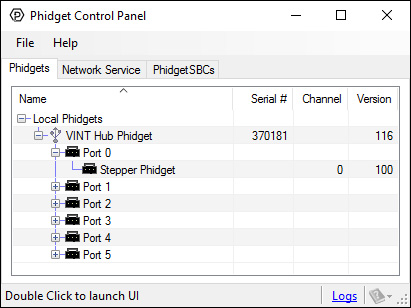STC1000 User Guide: Difference between revisions
No edit summary |
|||
| Line 1: | Line 1: | ||
[[Category:UserGuide]] | [[Category:UserGuide]] | ||
== | ==Getting Started== | ||
{{UGIntro|STC1000}} | |||
* | * [{{SERVER}}/products.php?product_id=STC1000 STC1000 Stepper Phidget] | ||
* | * {{VINTHub}} | ||
* | * [{{SERVER}}/?view=comparetable&rel=Phidget%20Cables Phidget cable] | ||
* | * USB cable and computer | ||
* 4-wire, 6-wire, or 8-wire bipolar stepper motor | |||
* | |||
===Connecting the Pieces=== | ===Connecting the Pieces=== | ||
Revision as of 19:37, 15 August 2017
Getting Started
Welcome to the STC1000 user guide! In order to get started, make sure you have the following hardware on hand:
- STC1000 Stepper Phidget
- VINT Hub
- Phidget cable
- USB cable and computer
- 4-wire, 6-wire, or 8-wire bipolar stepper motor
Connecting the Pieces
- Connect the STC1000 to the VINT Hub using the Phidget cable.
- Connect the stepper motor to the Phidget's output terminals. See your motor's data sheet or product page for wiring instructions.
- Connect the VINT Hub to your computer with a USB cable.
Testing Using Windows
Phidget Control Panel
In order to demonstrate the functionality of the STC1000, the Phidget Control Panel running on a Windows machine will be used.
The Phidget Control Panel is available for use on both macOS and Windows machines.
Windows
To open the Phidget Control Panel on Windows, find the ![]() icon in the taskbar. If it is not there, open up the start menu and search for Phidget Control Panel
icon in the taskbar. If it is not there, open up the start menu and search for Phidget Control Panel
macOS
To open the Phidget Control Panel on macOS, open Finder and navigate to the Phidget Control Panel in the Applications list. Double click on the ![]() icon to bring up the Phidget Control Panel.
icon to bring up the Phidget Control Panel.
For more information, take a look at the getting started guide for your operating system:
Linux users can follow the getting started with Linux guide and continue reading here for more information about the STC1000.
First Look
After plugging the STC1000 into your computer and opening the Phidget Control Panel, you will see something like this:

The Phidget Control Panel will list all connected Phidgets and associated objects, as well as the following information:
- Serial number: allows you to differentiate between similar Phidgets.
- Channel: allows you to differentiate between similar objects on a Phidget.
- Version number: corresponds to the firmware version your Phidget is running. If your Phidget is listed in red, your firmware is out of date. Update the firmware by double-clicking the entry.
The Phidget Control Panel can also be used to test your device. Double-clicking on an object will open an example.
Stepper Motor
Double-click on the Stepper object, labelled {{{2}}}, in order to run the example: [[Image:{{{1}}}_Stepper_Example.jpg|center|link=]]
General information about the selected object will be displayed at the top of the window. You can also experiment with the following functionality:
- Toggle the Engage button to provide power to the motor coils.
- By default, motor position, velocity, and acceleration are measured in sixteenths of a step. If you want to use different units, change the value in the Rescale Factor textbox.
- Use the Target Position slider to set a new target position. Change the Acceleration and Velocity sliders to speed up or slow down the {{{1}}}'s approach.
- Select the Velocity (Continuous) Control tab for continuous rotation instead of specifiying a position.
Testing Using macOS
- Go to the Quick Downloads section on the macOS page.
- Download and run the Phidget macOS Installer
- Click on System Preferences >> Phidgets (under Other) to activate the Preference Pane
- Make sure your device is properly attached
- Double click on your device's objects in the listing to open them. The Preference Pane and examples will function very similarly to the ones described above in the Windows section.
Testing Using Linux
For a general step-by-step guide on getting Phidgets running on Linux, see the Linux page.
Using a Remote OS
We recommend testing your Phidget on a desktop OS before moving on to remote OS. Once you've tested your Phidget, you can go to the PhidgetSBC, or iOS pages to learn how to proceed.
Technical Details
Power Consumption
The quiescent (idle) power consumption of the STC1000 varies depending on the amount of voltage it's supplied.

What to do Next
- Programming Languages - Find your preferred programming language here and learn how to write your own code with Phidgets!
- Phidget Programming Basics - Once you have set up Phidgets to work with your programming environment, we recommend you read our page on to learn the fundamentals of programming with Phidgets.
